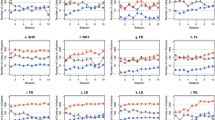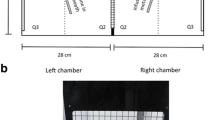Abstract
Rationale
Establishing a behavioral model for the effect of social environment on nicotine intake in rodents facilitates the investigation of molecular mechanisms critical for the interaction between social environment and cigarette smoking.
Objectives
Our main objective was to test the hypothesis that nicotine is the primary reinforcer in the socially acquired nicotine intravenous self-administration (IVSA) model by using an aversive flavor cue.
Methods
Adolescent female rats were placed in operant conditioning chambers equipped with two lickometers. Operant licking triggered concurrent deliveries of a flavor (i.e., taste and odor) cue containing either quinine or saccharin and an i.v. infusion (30 μg/kg nicotine or saline). An audiovisual cue was provided for some groups of rats. A second rat that did not receive nicotine was placed in the operant conditioning chambers to provide either a neutral or an inducing (i.e., by consuming the flavored solution) social environment. These two rats were separated by a divider that allowed orofacial interactions.
Results
Rats acquired stable nicotine IVSA with either the aversive or the appetitive flavor cue in the inducing social environment, and obtained similar amounts of infusions. The neutral social environment did not support nicotine IVSA with either cue. The audiovisual cue per se did not support nicotine IVSA but enhanced nicotine intake. Nicotine increased the number of concurrent nose pokes by the two rats into the center divider, a measure of social interaction.
Conclusions
Despite its aversive effects, nicotine is the primary reinforcer for the operant responses in the socially acquired nicotine IVSA model.




Similar content being viewed by others
References
Akers RL (1977) Deviant behavior: a social learning approach, 2nd edition. Wadsworth Pub. Co
Chen H, Matta SG, Sharp BM (2006) Acquisition of nicotine self-administration in adolescent rats given prolonged access to the drug. Neuropsychopharmacology 32:700–709
Chen H, Sharp BM, Matta SG, Wu Q (2011) Social interaction promotes nicotine self-administration with olfactogustatory cues in adolescent rats. Neuropsychopharmacology 36:2629–2638
Donny EC, Caggiula AR, Rowell PP et al (2000) Nicotine self-administration in rats: estrous cycle effects, sex differences and nicotinic receptor binding. Psychopharmacology 151:392–405
Eissenberg T, Balster RL (2000) Initial tobacco use episodes in children and adolescents: current knowledge, future directions. Drug Alcohol Depend 59(Suppl 1):S41–S60
Flay BR, Hu FB, Siddiqui O et al (1994) Differential influence of parental smoking and friends’ smoking on adolescent initiation and escalation of smoking. J Health Soc Behav 35:248–265
Friedman LS, Lichtenstein E, Biglan A (1985) Smoking onset among teens: an empirical analysis of initial situations. Addict Behav 10:1–13
Greenlund KJ, Johnson CC, Webber LS, Berenson GS (1997) Cigarette smoking attitudes and first use among third- through sixth-grade students: the Bogalusa Heart Study. Am J Public Health 87:1345–1348
Hahn G, Charlin VL, Sussman S et al (1990) Adolescents’ first and most recent use situations of smokeless tobacco and cigarettes: similarities and differences. Addict Behav 15:439–448
Heishman SJ, Kleykamp BA, Singleton EG (2010) Meta-analysis of the acute effects of nicotine and smoking on human performance. Psychopharmacology 210:453–469
Hofstetter CR, Hovell MF, Jung K-R et al (2007) The first puff: forces in smoking initiation among Californians of Korean descent. Nicotine Tob Res 9:1277–1286
Kalman D (2002) The subjective effects of nicotine: methodological issues, a review of experimental studies, and recommendations for future research. Nicotine Tob Res 4:25–70
O’Loughlin J, Paradis G, Renaud L, Sanchez Gomez L (1998) One-year predictors of smoking initiation and of continued smoking among elementary schoolchildren in multiethnic, low-income, inner-city neighbourhoods. Tob Control 7:268–275
Palmatier MI, Evans-Martin FF, Hoffman A et al (2005) Dissociating the primary reinforcing and reinforcement-enhancing effects of nicotine using a rat self-administration paradigm with concurrently available drug and environmental reinforcers. Psychopharmacology 184:391–400
Palmatier MI, Lantz JE, O’Brien LC, Metz SP (2013) Effects of nicotine on olfactogustatory incentives: preference, palatability, and operant choice tests. Nicotine Tob Res 15:1545–1554
Perkins KA, Donny E, Caggiula AR (1999) Sex differences in nicotine effects and self-administration: review of human and animal evidence. Nicotine Tob Res 1:301–315
Powell LM, Tauras JA, Ross H (2005) The importance of peer effects, cigarette prices and tobacco control policies for youth smoking behavior. J Health Econ 24:950–968
Spear SF, Akers RL (1988) Social learning variables and the risk of habitual smoking among adolescents: the Muscatine study. Am J Prev Med 4:336–342
Stolerman IP, Jarvis MJ (1995) The scientific case that nicotine is addictive. Psychopharmacology 117:2–10, discussion 14–20
Thiel KJ, Okun AC, Neisewander JL (2008) Social reward-conditioned place preference: a model revealing an interaction between cocaine and social context rewards in rats. Drug Alcohol Depend 96:202–212
Thiel KJ, Sanabria F, Neisewander JL (2009) Synergistic interaction between nicotine and social rewards in adolescent male rats. Psychopharmacology 204:391–402
Trezza V, Baarendse PJJ, Vanderschuren LJMJ (2009) Prosocial effects of nicotine and ethanol in adolescent rats through partially dissociable neurobehavioral mechanisms. Neuropsychopharmacology 34:2560–2573
Walter H, Abler B, Ciaramidaro A, Erk S (2005) Motivating forces of human actions. Neuroimaging reward and social interaction. Brain Res Bull 67:368–381
Wang T, Chen H (2014) Carbon disulfide mediates socially-acquired nicotine self-administration. PLoS One 9:e115222
Wang T, Han W, Wang B et al (2014a) Propensity for social interaction predicts nicotine-reinforced behaviors in outbred rats. Genes Brain Behav 13:202–212
Wang T, Wang B, Chen H (2014b) Menthol facilitates the intravenous self-administration of nicotine in rats. Front Behav Neurosci 8:437
White VM, Byrnes GB, Webster B, Hopper JL (2008) Does smoking among friends explain apparent genetic effects on current smoking in adolescence and young adulthood? Br J Cancer 98:1475–1481
Zernig G, Kummer KK, Prast JM (2013) Dyadic social interaction as an alternative reward to cocaine. Front Psychiatry 4:100
Acknowledgments
This work was supported by NIH DA-026894 (HC) and DA-037844 (HC). The authors thank Ms. Qingling Wu and Ms. Hongxiao Song for their excellent technical assistance and Dr. Jeffery Steketee for comments on the manuscript.
Author information
Authors and Affiliations
Corresponding author
Ethics declarations
All procedures were conducted in accordance with the NIH Guidelines Concerning the Care and Use of Laboratory Animals and were approved by the Institutional Animal Care and Use Committee of the University of Tennessee Health Science Center.
Conflict of interest
The authors have no conflict of interest to declare.
Additional information
Tengfei Wang and Wenyan Han contributed equally to this work.
Rights and permissions
About this article
Cite this article
Wang, T., Han, W. & Chen, H. Socially acquired nicotine self-administration with an aversive flavor cue in adolescent female rats. Psychopharmacology 233, 1837–1844 (2016). https://doi.org/10.1007/s00213-016-4249-2
Received:
Accepted:
Published:
Issue Date:
DOI: https://doi.org/10.1007/s00213-016-4249-2




